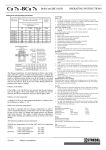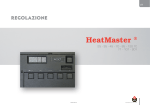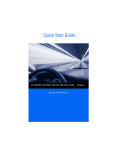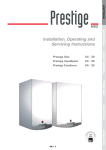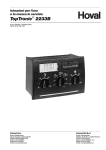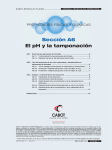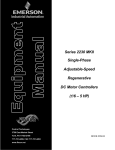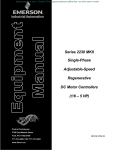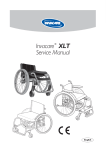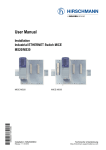Download Strebel Ca6s Installation Manual
Transcript
Ca 6s and BCa 6s 33-64 kW INSTALLATION AND OPERATING INSTRUCTIONS Page 1 31/07/00 CONTENTS: PAGE: General specification 3 Dimensions for Ca6s and BCa6s boilers. 4 Boiler room clearance requirements 5 Boiler block assembly 6 Boiler connections and jacket assembly 7 Diagram 8 BCa6s assembly 9 BCa6s electrical connections and jacket assembly 10 Diagram 11 Instrument control panel description 12 Continued 13 Control module options 14 Control module diagrams 15 Installation of electronic control modules 16 Terminal wiring diagram 17 Schematic wiring diagram 18 Important notes & burner connection information. 19 Page 2 31/07/00 ASSEMBLY INSTRUCTIONS FOR: Ca 6s / BCa 6s General Specifications The STREBEL Camino 6s is a special boiler for oil or gas fired pressure jet burner. In the BICALOR construction a calorifier for the supply of hot water is built onto the boiler. CSH-S type calorifier are manufactured from 1.4571 high tensile steel with an incorporated heating coil of galvanised copper ribbed pipe. Triple pass block of cast iron sections. The first pass is the combustion chamber. From there the flue gases pass between the rear section and the last intermediate section through the second pass to the front of the boiler. They are then diverted into the third pass and flow back to the rear through the flue spigot into the chimney. Calorifier: Maximum operating pressure 10 bar Maximum test pressure 13 bar The boiler can be delived in individual sections or as a boiler block. The accessories are packed seperately. There are different orders of assembly depending on the condition of supply. when assembling and connecting the boiler, all relevant instructions should be observed. The boiler is to be erected on a base, or a level floor which is capable of supporting the weight of the boiler, water content and any ancillary equipment. Refer to base details opposite. Assembly, connections and the initial set-up operation should be carried out by a qualified heating engineer. Flue baffles of cast iron can be introduced into the flue passes in order to influence the flue gas temperature depending on chimney conditions. The boiler can be used with an oil or gas burner. Brief description. • • • • • • Corrosion resistant block of cast iron sections. Triple pass boiler with optimised use of energy. High efficiency. Built-in instrument panel with multiple control possibilities and retro-fit control options. Easy erection and cleaning. Modern design. B Operating conditions Boiler: Maximum operating temperature up to 110ºC Maximum operating pressure 4.0 bar Maximum test pressure 5.2 bar A Min thickness = 60mm Ca6s-4 Ca6s-5 Ca6s-6 Dimensions A 940 1090 1240 B 760 760 760 Page 3 31/07/00 ASSEMBLY INSTRUCTIONS FOR: Ca 6s 7s / BCa 6s 7s Boiler Dimensions Ca6s LK 840 990 1140 Ca6s-4 Ca6s-5 Ca6s-6 Combustion chamber depth 600 750 900 BCa6s LK Ca6s-4 Ca6s-5 Ca6s-6 840 990 1140 CSH 175S 1010 LB CSH 235S 1310 1310 1310 CSH 305S 1610 1610 Page 4 31/07/00 ASSEMBLY INSTRUCTIONS FOR: Ca 6s 7s / BCa 6s 7s Diagram showing clearances required in boiler room. The clearance details shown above are required for access to the boilers for maintenance purposes. Slight variations may apply, depending on the specific installation. Page 5 31/07/00 ASSEMBLY INSTRUCTIONS FOR: Ca 6s 7s / BCa 6s 7s Boiler Block Assembly The boiler block is assembled by ‘pulling-up’ each section in turn starting from the rear section (1). All other sections (2)(3)(4) are mounted individually using the pulling-up tools. One face of the adjoining sections must have a length of mastic sealing strand placed into the mastic groove. Each of the boiler nipples must be inspected to ensure there is no damage apparent. The nipples and nipple ports should then be kept free from dirt and checked at each stage of assembly. Particles of dirt which are not removed lead to leakage. The accompanying nipple jointing oil serves as a lubricant as well as a waterproof seal and must be used. Boiler nipples and nipple ports must align exactly at all stages of assembly. An inclined, retracted nipple leads to leakage. The clearance between the sections throughout the pulling-up stages should always be even. If the clearance is uneven, a flat chisel should be inserted into the narrower point and the sections pulled up until the clearance is even again. Once assembled, the boiler block is to be secured with the tie bars (2 at the top, and 2 at the bottom). Prior to screwing nuts up ensure the two disc springs (5)&(6) are slotted on with concave sides facing each other. The nuts can now be tightened until the disc springs flatten. The burner door hinges should now be fitted on the left or right hand side of the front section depending on requirements. Ensure the eyelet screws (door hinge) are at the same depth and when the door is closed it should press flat with the front section. Diagram showing nipple & boring Page 6 31/07/00 ASSEMBLY INSTRUCTIONS FOR: Ca 6s 7s / BCa 6s 7s Connections and jacket assembly Important points: The diagram over the page shows the assembly of the Ca6s connections and jackets. The burner door can be fitted to swing from either the left or right. Fit hinge bolts accordingly and ensure there is even pressure around door seal by adjusting the depth of the eye holes for the hinge. The order of assembly from (1) to (24) must be observed. Note: The burner plug must be mounted on the opposite side. Key to components: 1. 2. 3. 4. 5. 6. 7. 8. 9. 10. 11. 13. 14. 15. 16. 17. 18. 19. 20. 21. 22. 23. 24. 25. Left hand lower insulation. Right hand lower insulation. Left hand jacket with insulation. Right hand jacket with insulation. Front bottom bracing angle. Lower door jacket bracing. Upper front insulation. Upper front jacket panelling. Calorifier blanking flange. Top jacket insulation. Inner rear insulation. Burner connection. Capillaries. Top Jacket. Flow header and flange. (Fitted eccentrically upwards). Return header and flange. (Fitted eccentrically upwards). Calorifier blanking flange. Drain cock connection. Rear jacket angle. Outer rear insulation. Rear insulation retainer. Rear insulation retainer. Flue gas spigot. Front Jacket & front shroud. When assembling the floor insulation (1) & (2) as well as the side jackets (3) & (4) care should be taken to ensure they are in the correct position (with burner cable holes facing the front). The water temperature sensors (14) must be pushed with the pressure spring into the immersion sleeves (max. 3 per sleeve) and then secured with the protective guard. Note: The sensor leads (capillary tubes) should not be kinked. Cold water pressure test: The assembled boiler is to be subjected to a cold water pressure test of 1.5 times the operating pressure. The maximum test pressure of the boiler is 5.2 bar. In addition, at the time of testing for water pressure, no pressure control fittings or safety fittings may be assembled which cannot be separated from the water area of the boiler. Only fill, slowly from the bottom via the filling and draining cock. Ventilate during the filling procedure from time to time, until the water emerges. If a nipple connection is leaking then drain off the water via the filling and draining cock. Separate by driving flat wedges around the perimeter of the join between sections. New nipples MUST be used for reassembly. Assemble and repeat test. Page 7 31/07/00 Ca 6s 7s / BCa 6s 7s Ca6s ASSEMBLY INSTRUCTIONS FOR: Page 8 31/07/00 ASSEMBLY INSTRUCTIONS FOR: Ca 6s 7s / BCa 6s 7s BCa7s Assembly Follow the steps below for completion of the assembly. The diagram shows the calorifier connections and mounting brackets. Key: 1. 2. 3. 4. 5,7,8 6. 9. Flow connections Return connections Mounting bracket Calorifier primary flow connection Calorifier primary return connections Non-return valve and charging pump. Drain cock connection Page 9 31/07/00 ASSEMBLY INSTRUCTIONS FOR: Ca 6s 7s / BCa 6s 7s BCa6s electrical connections and jacket assembly. The diagram over the page shows the assembly for the BCa6s including electrical connection and final jacket assembly. 1. 2. 3. 4. 5. 6. 7. 8. 9. 10. 11. 12. 13. 14. 15. 16. 17. 18. 19. 20. 21. 22. 23. Angled bracket with pipework slots. Jacket alignment bracket. Left hand side jacket. Right hand side jacket. Calorifier top insulation. Top jacket. Jacket mounting bracket. Instrument control panel. Calorifier door. Sensor capillaries. Boiler sensors. Thermostat sensor. Calorifier thermometer. Burner cable outlet. Alternative burner cable outlet (depending on hinge placement) Rear boiler insulation. Insulation retaining brackets. Lower rear calorifier insulation. Rear calorifier insulation. Rear insulation retainers. Flue gas spigot. Front calorifier insulation. Boiler front jacket. Note: Mains connection should be made via the rear of the boiler through to the control panel. It must not be connected directly to the front of the boiler via the calorifier jacket door. Page 10 31/07/00 ASSEMBLY INSTRUCTIONS FOR: Ca 6s 7s / BCa 6s 7s Page 11 31/07/00 ASSEMBLY INSTRUCTIONS FOR: Ca 6s 7s / BCa 6s 7s ELECTRICAL CONNECTION Description of Controls and Operation. A – On / Off and Operation mode switch Switch position “0” (off) With the switch in this position, the operation of the boiler and burner is off. Switch position “1” (manual) The instrument panel is in operation. The burner and any boiler control pumps are operated with out any influence of any other built in control modules. The dial controls the boiler operating temperature within the limits of the decreasing arrow. Mixing valves must be manually adjusted. The instrument panel On lamp (G) is illuminated. Switch position (automatic) In this position, any built in electronic modules are in operation. The boiler temperature and any other equipment connected back to the boiler i.e. pumps and mixing valves are controlled automatically. Attention: The switch marked “0” (off) can only be reached by rotating the switch anti-clockwise through the position marked “1”. Switch position (STB) This function is used to check the boiler safety limit thermostat. This is activated by rotating the dial and holding the switch in position until the boiler safety limit thermostat functions. B – Boiler safety limit thermostat (STB) The boiler safety thermostat (STB) turns the boiler off if the boiler water temperature overheats. Once the boiler water has cooled down to about 80ºC, the STB must be manually re-set. This is done by unscrewing the cover cap (B) and pressing the small button. Once reset refit the cover cap again. If the STB functions repeatedly, check the water circulation through the boiler or call a heating engineer. C – Fuse (6.3A) A fuse in the front of the instrument panel protects all the controls and any other equipment connected back to the boiler. A defective fuse must be replaced by an identical one. Attention: Before the fuse is replaced, the instrument panel must be isolated from the electrical power supply. Page 12 31/07/00 ASSEMBLY INSTRUCTIONS FOR: Ca 6s 7s / BCa 6s 7s D – Boiler thermometer Safety instructions It shows the actual boiler water temperature and has no influence on the boiler temperature control. Any servicing on the boiler instrument panel (wiring, repairs, changes) should be carried out by a competent person. If any works are carried out the mains supply to the boiler must be isolated and secured against accidental switching on. The proper function of the boiler instrument panel is only guaranteed according to our general guarantee conditions and only if the installation and operation is carried out in accordance with these instructions. E – Burner lock out lamp (red) The red lamp will illuminate when the burner has gone out (burner fault), the red lamp will go off once the burner reset button has been pressed. F – high limit lamp (orange) If the boiler safety limit thermostat (STB) is activated, the orange control lamp will be illuminated. The orange lamp will go off once the STB button has been pressed and reset. G – Instrument panel “On” lamp (green) This will be illuminated when the instrument panel is switched on, the main On – Off switch (A) turned from “0” to “1”. H – Blank cover The standard version of the boiler instrument panels are supplied with blank covers. Terminal blocks X3 and X4 connect to dummy connection pins on the rear side to prevent short circuits. When using an additional electronic control module, this blank cover should be removed. Terminal blocks X3 and X4 should then be connected to the replacement module along with X1 and X2 (in the designated positions). I – Blank cover When a Gamma 1B control module is used, this blank cover must be removed. A Summer/Winter switch is fitted here. Page 13 31/07/00 ASSEMBLY INSTRUCTIONS FOR: Ca 6s 7s / BCa 6s 7s Control module options Two stage burner operation Single stage burner operation G22K Electronic two stage thermostat for constant temperature boiler operation. (illustration on page 7) Gamma 1B HWS control, temperature range 20 – 80ºC, HWS priority, pump overrun of calorifier primary pump, boiler control thermostat. (illustration on page 7) Gamma 22B Weather compensated control for two stage operation for one heating circuit and HWS control. Gamma 223B Weather compensated control for two stage operation for one heating circuit, one mixing valve and HWS control. (illustration on page 7) Gamma 2B Weather compensated control for one heating circuit and HWS control. Gamma 23B Weather compensated control for one heating circuit, one mixing valve and HWS control. Gamma 233B Weather compensated control for one heating circuit, two mixing valves and HWS control. Gamma 2233B Weather compensated control for two stage operation for one heating circuit, two mixing valves and HWS control. (illustration on page 7) Gamma 233BS Weather compensated control for one heating circuit, two mixing valves, HWS control, temperature difference control for solar units and combination with solid fuel boilers. Gamma 33B Weather compensated control for two heating circuits both with mixing valves. This is an additional control module, suitable only in addition to a basic electronic control module. Gamma 33B Weather compensated control for two heating circuits both with mixing valves. This is an additional control module, suitable only in addition to a basic electronic control module. Mounting and operating instructions are supplied with the electronic controls. Page 14 31/07/00 ASSEMBLY INSTRUCTIONS FOR: Ca 6s / BCa 6s Gamma B1 Control Module. G22K Control Module. Gamma 223B control module. Gamma 2233B Control Module. Page 15 31/07/00 ASSEMBLY INSTRUCTIONS FOR: Ca 6s 7s / BCa 6s 7s Gamma B1 If a further control module is to be added, open the top metal cover of the boiler instrument panel by removing the 6 screws First the blank cover on the boiler needs to be removed. Use a screwdriver with light pressure turning anti-clockwise the screws on the left and the right side of the blank cover. Then remove the blank cover carefully as there is wiring connected to the back. Remove the plugs X3 and X4 from the back of the blank cover. Connect the plugs X1, X2, X3, and X4 from the boiler instrument panel to the back of the control module. Insert the electronic control module into the opening and fix it by turning the two screws under light pressure clockwise by 90º. The electronic control module unit is now fixed to the boiler instrument panel. Screw the terminal block X11 that is supplied with the additional control module onto the red marked part of the terminal rail inside the boiler instrument panel, and likewise the X12 onto the blue marked part (2.9 x 19mm screws are supplied with the additional control module). Connect the plugs X9.1 and X10.1 that are on the leads to the boiler instrument panel with X9.2 and X10.2 plugs and leads from the additional control module. If a second extension module is used, connect the clips of the second one. Remove the central blank cover and connect the plugs X1, X2, X3 and X4 to the module. Install the module as described above. Installation of an electronic control module . Page 16 31/07/00 Page 17 31/07/00 Connect plugs X10 with X10.1 of the previous module Flow sensors for the relevant mixing circuit STREBEL Ltd (01276) 685422 Calorifier primary pump Mixer valves for the relevant mixing circuit VF 3/4(5/6) SLP 2(3) Circulating pumps for the relevant mixing circuit MKP 3/4(5/6) Mixer 3/4(5/6) Mains supply extension Connect plugs X9 with X9.1 of the previous module Data extension Extension module 1(2) SF1 VF1 VF2 AF2 KF2 MKP3/4(5/6) SLP2(3) VF3/4(5/6) Data bus RS-10 MK1 KK SK Burner connection cable Burner connection cable * AF1 Abbreviation L-MV BZ1 BZ2 KKP SLP1 MKP1 MKP2 KF1 sensor (AF1), should have 1.6 k ohms resistor (supplied) fitted in its place. * = 2 stage combination boilers fitted with G 22 BC module but no outside ** [1]-[6] Boiler flow sensor (KVT) Boiler flow sensor (KVT) Calorifier circulating pump sensor (KVT) Calorifier pump cable (SLP) ** TERMINAL WIRING DIAGRAM KF1 (terminals 50+51) KF2 (terminals 61+58 GND) SF1 (terminals 54+55) Terminal 15 live Terminal 16 neutral Outside sensor AF200 / 1.6k resistor * Calorifier sensor KVT 20/5/6 5m Flow sensor VF202 for mixing circuit 1 flow sensor VF202 for mixing circuit 2 Outside sensor AF200 Boiler sensor KVT 20/5/6 5m Circulating pumps for the relevant mixing circuit Calorifier primary pump Flow sensors for the relevant mixing circuit For room sensor and room device Room sensor Mixing circuit 1 Boiler circulation Provision for remote burner cicuit Stage 1 (terminals 27 - 32) Stage 2 (terminals 33 - 36) Burner cable numbers Description Fuel supply solenoid valve (where applicable) Burner run signal, stage 1 Burner run signal, stage 2 Boiler circulating pump Calorifier primary pump 1 Mixing circuit 1 circulating pump Mixing circuit 2 circulating pump Boiler sensor KVT 20/5/6 5m KFG INSTRUMENT CONTROL PANEL WIRING DIAGRAM IN TOTALCAD FILE INSERT HERE Page 18 31/07/00 ASSEMBLY INSTRUCTIONS FOR: Ca 6s 7s / BCa 6s 7s IMPORTANT: Flue-gas temperatures of below 160ºC can lead to sooting of the flue, when entering a stone or brick chimney. Where flue-gas temperatures are below 160ºC gross, specially adapted chimneys must be available. If after the burner has been set, the flue-gas temperature is too low, the baffles from the 3rd flue pass can be taken out. If necessary, the 2nd flue pass baffles can also be removed. NB: Every change made to the flue baffles requires re-commissioning of the burner settings. Electrical connections must be carried out by qualified personnel in accordance with instructions supplied. Electrical leads and oil pipes should never be fastened to the boiler casing. In the interest of technical progress, we reserve the right to undertake changes and improvements in production without notification. Please refer to ‘Operating and Maintenance’ information for details on baffles and control panel information. When connecting the burner, make sure the length of the burner cable is such that when the burner door is opened it becomes disconnected. Page 19 31/07/00 ASSEMBLY INSTRUCTIONS FOR: Ca 6s 7s / BCa 6s 7s THE COMPANY RESERVES THE RIGHT TO CHANGE SPECIFICATIONS AND DIMENSIONS WITHOUT NOTICE STREBEL LTD 1F Albany Park Industrial Estate Frimley Road, Camberley, Surrey, GU16 7PB Telephone: 01276 685422 Fax: 01276 685405 E-mail address: [email protected] Website: www.strebel.co.uk E. & O.E Page 20 31/07/00





















